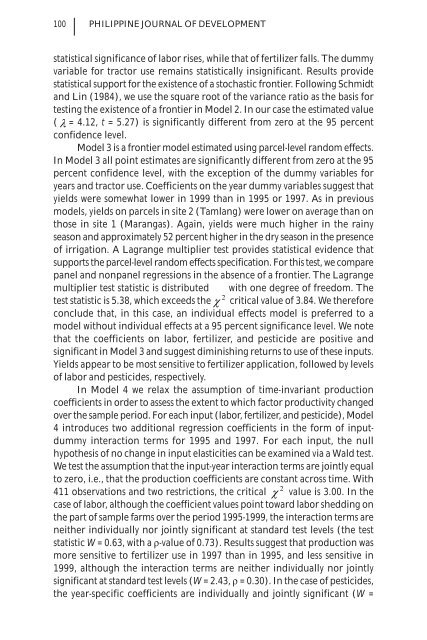Panel Data Evidence from Irrigated Rice Production in Southern
Panel Data Evidence from Irrigated Rice Production in Southern
Panel Data Evidence from Irrigated Rice Production in Southern
Create successful ePaper yourself
Turn your PDF publications into a flip-book with our unique Google optimized e-Paper software.
100 PHILIPPINE JOURNAL OF DEVELOPMENTstatistical significance of labor rises, while that of fertilizer falls. The dummyvariable for tractor use rema<strong>in</strong>s statistically <strong>in</strong>significant. Results providestatistical support for the existence of a stochastic frontier. Follow<strong>in</strong>g Schmidtand L<strong>in</strong> (1984), we use the square root of the variance ratio as the basis fortest<strong>in</strong>g the existence of a frontier <strong>in</strong> Model 2. In our case the estimated value( λ = 4.12, t = 5.27) is significantly different <strong>from</strong> zero at the 95 percentconfidence level.Model 3 is a frontier model estimated us<strong>in</strong>g parcel-level random effects.In Model 3 all po<strong>in</strong>t estimates are significantly different <strong>from</strong> zero at the 95percent confidence level, with the exception of the dummy variables foryears and tractor use. Coefficients on the year dummy variables suggest thatyields were somewhat lower <strong>in</strong> 1999 than <strong>in</strong> 1995 or 1997. As <strong>in</strong> previousmodels, yields on parcels <strong>in</strong> site 2 (Tamlang) were lower on average than onthose <strong>in</strong> site 1 (Marangas). Aga<strong>in</strong>, yields were much higher <strong>in</strong> the ra<strong>in</strong>yseason and approximately 52 percent higher <strong>in</strong> the dry season <strong>in</strong> the presenceof irrigation. A Lagrange multiplier test provides statistical evidence thatsupports the parcel-level random effects specification. For this test, we comparepanel and nonpanel regressions <strong>in</strong> the absence of a frontier. The Lagrangemultiplier test statistic is distributed with one degree of freedom. The2test statistic is 5.38, which exceeds the χ critical value of 3.84. We thereforeconclude that, <strong>in</strong> this case, an <strong>in</strong>dividual effects model is preferred to amodel without <strong>in</strong>dividual effects at a 95 percent significance level. We notethat the coefficients on labor, fertilizer, and pesticide are positive andsignificant <strong>in</strong> Model 3 and suggest dim<strong>in</strong>ish<strong>in</strong>g returns to use of these <strong>in</strong>puts.Yields appear to be most sensitive to fertilizer application, followed by levelsof labor and pesticides, respectively.In Model 4 we relax the assumption of time-<strong>in</strong>variant productioncoefficients <strong>in</strong> order to assess the extent to which factor productivity changedover the sample period. For each <strong>in</strong>put (labor, fertilizer, and pesticide), Model4 <strong>in</strong>troduces two additional regression coefficients <strong>in</strong> the form of <strong>in</strong>putdummy<strong>in</strong>teraction terms for 1995 and 1997. For each <strong>in</strong>put, the nullhypothesis of no change <strong>in</strong> <strong>in</strong>put elasticities can be exam<strong>in</strong>ed via a Wald test.We test the assumption that the <strong>in</strong>put-year <strong>in</strong>teraction terms are jo<strong>in</strong>tly equalto zero, i.e., that the production coefficients are constant across time. With2411 observations and two restrictions, the critical χ value is 3.00. In thecase of labor, although the coefficient values po<strong>in</strong>t toward labor shedd<strong>in</strong>g onthe part of sample farms over the period 1995-1999, the <strong>in</strong>teraction terms areneither <strong>in</strong>dividually nor jo<strong>in</strong>tly significant at standard test levels (the teststatistic W = 0.63, with a ρ-value of 0.73). Results suggest that production wasmore sensitive to fertilizer use <strong>in</strong> 1997 than <strong>in</strong> 1995, and less sensitive <strong>in</strong>1999, although the <strong>in</strong>teraction terms are neither <strong>in</strong>dividually nor jo<strong>in</strong>tlysignificant at standard test levels (W = 2.43, ρ = 0.30). In the case of pesticides,the year-specific coefficients are <strong>in</strong>dividually and jo<strong>in</strong>tly significant (W =










